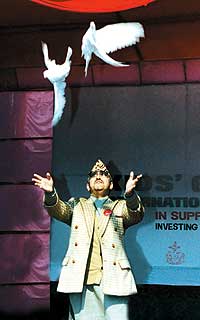 Two years have passed since the demise of King Birendra. But, the recent turns of events in the country frequently remind us of the late monarch. Many have wondered how he would have handled the country's present dangerous and chaotic situation, were he still alive.
Two years have passed since the demise of King Birendra. But, the recent turns of events in the country frequently remind us of the late monarch. Many have wondered how he would have handled the country's present dangerous and chaotic situation, were he still alive. King Birendra had an uncanny knack of finding compromises and wresting a peaceful resolution in times of trouble. During his coronation when he addressed the people using words like "me and my wife", it won him praise from liberal Nepalis. He showed an uncanny ability to break down walls and stand by the people. In 1979, he allowed a referendum on absolute monarchy, reflecting his commitment to defuse a crisis through consensus and not by suppression.
Of course, the referendum was by no means fair. That is why the late BP Koirala suggested that the minority in the results of the referendum should be respected and that there should be an earnest effort to make reforms accordingly. But, ultimately, the third amendment of the Panchayat constitution cheated the people and took them for a ride.
The popular 1990 Movement is yet another reason to remember King Birendra. Hardly a month-and-a-half after the movement began, the king handed his power to the leader of the People's Movement and agreed to be a constitutional monarch. Once again, he tore down walls between the people and himself.
Critics have charged that the late King Birendra broke the rules of a constitutional monarch. When the framework of the present constitution was still being made, top brass of the army had reached Singha Darbar to propose that the sovereignty should not be vested in the people. Even after the new constitution was promulgated, the king, against the spirit of the constitution, kept the tradition of appointing ambassadors. He also nominated members of the Upper House without the recommendation of the cabinet.
But despite these example cited by critics, King Birendra was always known as a constitutional monarch. That is because most of his work in the last 12 years were very much within the constitutional framework. During his tenure, the constitution was protected and the monarch even pardoned some mistakes made by the people's representatives.
When he bowed to people power in 1990, the king did not become less popular. In fact, that was the turning point after which his popularity soared. Why was the king always criticised before 1990 and not after the popular movement? After all, it was the same king who vacillated during the peoples' movement. But once the nation was unshackled and the people could elect their representatives to find a prime minister, the target of public criticism and even that of the Maoists were the parliament, the political parties and their leaders. When the king was active, and his role absolute, he was the target of criticism. From the day he chose to be a constitutional monarch, the king had a buffer. Our country is once again under the direct rule of the king. The state once more arrests students for chanting seditious slogans, and it releases them to keep the situation under control. Alarm bells are clanging. The constitution that was designed to narrow the gap between the king and people, is being battered. The distance between the present monarch and his subjects is widening. King Birendra granted the royal seal to this constitution. Perhaps we should respect this document in his memory on his birth anniversary.


